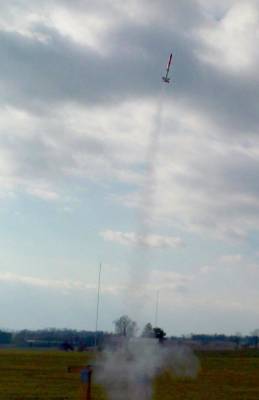The Viper: A '70s kit offered to Estes Aerospace Club (EAC) members. It uses T motors. It is a good, economical flier with parachute recovery. The small 12-inch parachute is a good choice for this rocket, since it is limited to A-power only. I wouldn't waste the time using 1/4A motors unless it's extremely windy or you have an extremely small field, the larger motors are so much more satisfying.
This particular Viper was painted with Purple and Orange instead of the Purple and Yellow. I suppose that was because I had orange dope and no yellow, but that was 35 years ago, who knows?
This rocket was later given my "Iris" modification, which extends the body tube about 5 inches above the streamer / parachute bay, and allows for a payload with an Altimeter One to measure altitudes. With it’s most powerful A motor, I can’t seem to get this above the 200-foot mark. (Iris is named after the Greek god of the rainbow. She is a messenger of the gods, linking the gods with humanity.) This rocket has flown higher than the Cape Hatteras Lighthouse in NC, the tallest lighthouse in the USA.
| Flight Date: | 2012-02-05 |
| Rocket Name: | EAC Viper |
| Kit Name: | Estes - E.A.C. Viper {Kit} (0820) [1972-1986] |
| Flyer's Name: | Rich DeAngelis |
| Motors: | A3-4 |
| Launch Site: | Penn Manor School Lancaster PA |
| Actual Altitude: | 179 Feet |
Yet another sport flight for the Viper. It was cold and a bit windy. I didn't know if the chute would open in the 40-degree weather, but I didn't care since this is a small model. I knew this model will fly straight in windy conditions so I chose it for the first flight of this February day. The A3-4T motor burned for a full second and accelerated the rocket at 7.1 Gs, averaging 2.8 Gs for the burn. It reached a speed of 61 mph and had an apogee of 179 feet. It then coasted for 1.3 seconds and fell to 148 feet before ejection, and descended with a partially deployed but somewhat inside-out parachute. It descended fast at 14 mph and landed 18.9 seconds later. Good flight!
| Stage | Motor(s) |
|---|---|
| 1 | Estes A3T-4 |
Sponsored Ads
 |
 |












